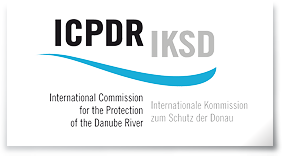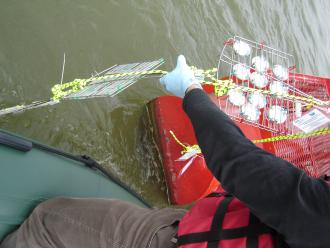Hungary
The JDS4 main program was carried out from 1st July to 5th July (fish survey until 30th July) in Hungary by hydrobiologist experts of Danube Research Institute, Hungarian Academy of Sciences Centre for Ecological Research and chemist experts of Governmental Office of Pest County and Wessling Hungary Ltd.
Water and sediment phase was sampled during the JDS4program together with completion of a detailed biological sampling program for 6 biological elements, general physico-chemical components and special survey for environmental-DNA, chemical compounds, organic substances and radioactivity at each sites.
Altogether 12 sampling locations were nominated in the Hungarian water shad (11 for Danube, 1 for Tisa river). According to the official agreement achieved on the Monitoring and Assessment Working Group in 2018 Hungarian National Expert Team sampled 9 JDS4 sites, the Vámosszabadi-Medve Danubian cross section was sampled by the Slovakian National Expert Team and the Hercegszántó-Batina-Bezdán Danubian site together with the Tiszasziget-Martonos Tisza site was sampled by the Serbian-Croatian National Expert Team.
The transport of samples was organized and fulfilled during the last few weeks. All samples arrived to the appropriate Laboratory for further analysis in proper time.
The microplastic sampling (MP) – which was finished on 25 July - was also a success. Without any real trial we had to struggle with some technical difficulties. A special framework was welded and fixed to the catamaran buoy to hold the MP sedimentation sampler with chains. Some floating pieces of wood hit the sampler and aggregated to the sampler. There was no difficulty during the removal of the sampler, but a crane was necessary to remove the altogether 100 kg weight sampler filled with sediment and water and the framework.

(The deployment of the sediment MP sampler upstream Budapest)

The removal of the sampler downstream Budapest

Emptying the sampler

The re-suspended sediment was quantitatively rinsed into the sample delivery vessel.
JDS4-17: Mosoni-Danube, Vének
The lowest section of the Mosoni-Danube is characterized by very slow current (thick sedimentation is observed along both sides of the river bed) together with rich mussel community (Unionidae). Rough sand occurs only in the middle zone together with a Corbicula fluminea stock.

The cross section of Mosoni-Danube at Vének next to the ferry place

Unio tumidus (38 specimen), U. pictorum (19 specimen) és Anodonta anatina (4 specimen) at Vének, Mosoni-Danube
The most common species is Unio tumidus followed by Unio pictorum but the pond mussel (Anodonta anatina) is found also.

Phytobenthon sample processing at Vének (big sized gravel was found only in an artificial deposition of the constructed port area)
JDS4-18: Gönyű
The Danube-section of Gönyű represents the beginning of the Middle Danube section type having relatively strong current and rough gravel bed on the shore, as well. The bed slope decreases here passing the gravel field of the Szigetköz inland delta. Gravel mixed with sand characterizes this section type until Dunaföldvár - Paks where the Lower Danube section type is starting downstream.

The rough gravel deposition on the bank is formed by the strong current. Mussels are not able to exist in this permanently changing habitat.

The expert group is ready for the macrophytes sampling

Thick (> 10 cm) sludge deposition is found in the current shadow area where the sediment core samples were taken
JDS4-22: Szob

Both banks were visited by motorboat for phytobenthos sampling

Goosander family (Mergus merganser) the mother is on the left with her six chicks. This bird is very rarely found in Hungary. We detected them at Szob on the right bank

The North American Orconectes limosus nowadays is very frequently found Decapoda species along the Middle Danube
JDS4-23: Budapest upstream, Megyeri bridge

Very thick layer of fine sediment is deposited along the shallow banks in large areas during the long lasting high water level conditions. A lot of mussels died due to the sludge coverage. Only few specimens were found upstream Budapest during the JDS4 program

Result of cross section dredging at Dunakeszi: right, middle and left side

The detection of the rare saucer bug (Aphelocheirus aestivalis) illustrates well the high efficiency of the dredging method

National expert team at Dunakeszi
JDS4-24: Budapest downstream, southern M-0 bridge

Sampling site on the left bank downstream Budapest

Result of cross section dredging at M-0 bridge: right, middle and left side
JDS4-25: Tass, lower end of Ráckevei-Soroksári Danube (RSD)

Native sponge species with alien chineese pond mussel (Sinanodonta woodiana) found on the lower section of the RSD

Pectinatella magnifica bryozoa became very frequent invader along the RSD. József Szekeres, who published this from here found this animal colony again
JDS4-26: Dunaföldvár

Three parallel sediment core sample taken at Dunaföldvár, on the right bank

Large stones and rocks are frequently occur at Dunaföldvár cross section in the middle dredged sample
JDS4-27: Paks

The left bank at Paks contains a lot of sedimented sludge with sine sand fraction

Meeting and visiting the German ship volunteers at Paks, who provide online measurements for the JDS4 program of the ICPDR
JDS4-28: Baja

Mussels and sediment core sample collected at Baja
Fish were sampled using both day and night time electric fishing at 9 main sites along the Hungarian section of the Danube. The survey proved abundant populations of strictly protected endemic species, such as the Zingel (Zingel zingel) and the Danube streber (Zingel streber). It also proved the continuing invasion of the round goby (Neogonius melanostomus) in the Middle-Danube, which still proved to be the most dominant benthic fish.

Going for night time electric fishing at Paks

Sampling and measuring fish in the Hungarian section of the Danube at night

Day time electric fishing in the Danube in Hungary. Bleak (Alburnus alburnus) is the most abundant species in the samples

Measuring chub (Squalius cephalus)

The European catfish (Silurus glanis) proved to be abundant along the whole Hungarian Danube section

Razor fish (Pelacus cultratus), a rare species from the Danube

The round goby (Neogobius melanostomus) is the most invasive benthic species in the Danube

The Zingel (Zingel zingel) and the Danube streber (Zingel streber) are strictly protected endemic species in the Danube. The JDS4 survey proved that both species are still abundant along the Hungarian section of the river


National coordinator, colleagues from General Directore of Water Management and environmental engineer students from University of Civil Service join actively to the fish sampling

The Hungarian fishing national team are happy after success sampling




































